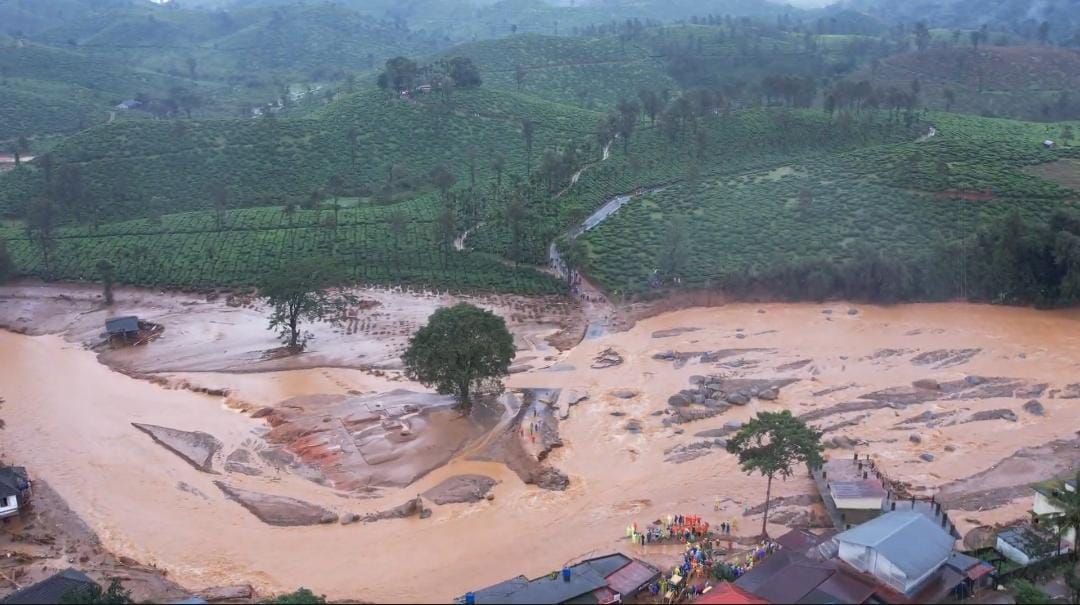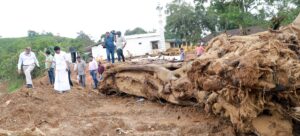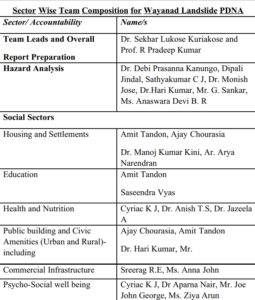The process is expected to guide the state and district authorities in making informed decisions about where and how to allocate resources for rebuilding, ensuring that the affected areas in Wayanad can recover swiftly and sustainably from the savage disaster.
Published Aug 28, 2024 | 7:00 PM ⚊ Updated Aug 28, 2024 | 7:00 PM

An aerial view of landslides-ravaged area in Wayanad.
A Post-Disaster Needs Assessment (PDNA) process is on at the landslide-hit areas in Wayanad to evaluate the damage and chart a comprehensive recovery strategy.
At least over 230 people were killed in a series of landslides at Attamala, Mundakkai, and Chooralmala on 30 July. The search for the dead is continuing, as 119 others are still missing, almost a month after the disaster.
The PDNA, which began on 26 August, and will continue through 31 August, is being conducted by teams from the National Disaster Management Authority (NDMA), National Institute of Disaster Management (NIDM), Kerala State Disaster Management Authority (KSDMA) and other agencies.
The process is expected to guide the state and district authorities in making informed decisions about where and how to allocate resources for rebuilding, ensuring that the affected areas in Wayanad can recover swiftly and sustainably from the savage disaster.
According to NIDM, the PDNA is a multi-sectorial and multidisciplinary structured approach for assessing disaster damages, losses, impacts, and needs that will lead to developing a recovery and reconstruction plan.
The KSDMA pointed out that the process is being carried out as per the ‘Standard Operating Procedures – PDNA India’ chalked out by the NIDM. As per the SOP, the PDNA consists of four main elements: Pre-disaster context and baseline information, assessment of disaster effects, assessment of disaster impacts; and recovery strategy and determining sector recovery needs.
The SOP stipulates that all activities undertaken as part of the recovery strategy must consider the principle of building back better (BBB).
The landslides, which struck at 86,000 square meters at the length of 8 km at Meppadi Grama Panchayat’s Attamala, Mundakkai, and Chooralmala wards resulted in the loss of lives of 231 individuals and the missing of 119 individuals.

PDNA assessment at Wayanad
As part of the PDNA, hazard analysis, assessment of social sectors, infrastructure, productivity, and cross-cutting will be carried out.
– Social sectors comprise housing and settlements, education, health and nutrition, public building, civic amenities (urban and rural), commercial infrastructure and psycho-social well-being
– Infrastructure comprises drinking water and sanitation, roads and bridges, power, irrigation (minor canals/traditional irrigation system)
– Productive comprises agriculture and horticulture (including plantations and agriculture labour), animal husbandry and livestock, tourism, MSME, small/local businesses, livelihoods
– Cross-cutting involves disaster risk reduction, forest and environment, and social inclusion (tribals, elderly, persons with disability, and gender perspectives)

Sector-wise PDNA assessment
“The objective of the PDNA is to assess the damages caused by the landslide and define a strategy for recovery and reconstruction, including estimation of financial costs across the impacted sectors,” read an excerpt from the Terms of Reference of the PDNA.
The assessment aims to evaluate the overall impact on the lives, livelihoods, and properties of the affected communities, focusing on sectors such as social, productive, health, infrastructure, tourism, livelihoods, forest and environment, and disaster risk reduction (DRR).
Emphasizing the importance of gender and tribal inclusion, the PDNA seeks to develop a comprehensive Recovery and Reconstruction Strategy that addresses immediate, medium-, and long-term needs, complete with cost estimates and a timeline.

PDNA assessment at Wayanad
Central to this strategy is the integration of disaster risk reduction principles and the concept of “building back better,” ensuring that gender and environmental concerns are at the forefront.
Furthermore, the assessment will consider the unique ecological and geographical challenges faced by the affected communities, recommending strategies for effective disaster risk management and proposing institutional mechanisms and policy options to foster long-term resilience.
An overall “build back better” cost will also be recommended, taking into account the sectoral needs identified through the assessment.
Though the KSDMA is leading the PDNA exercise, it is jointly supported by the NDMA, NIDM, and other agencies.
A multi-stakeholder state-level team, comprising sector experts, government representatives, international organizations, and other stakeholders concerned, has been constituted by KSDMA.
At the district level, the effort will be spearheaded by the District collector, supported by members of various departments, including Public Works, Local Self-Government Engineering, Minor Irrigation, Water Authority, Kudumbashree, and others.
Officials said that a coordinated approach has been established, with clear roles, responsibilities, and deadlines, to define the scope and objectives of the PDNA.
Experts from NDMA, NIDM, and other agencies conducted training for the teams, focusing on data collection, damage assessment, recovery needs, and report writing.
NDMA also provided templates and technical inputs to ensure the thorough assessment of sector-wise damage, cost estimates, and recovery strategies.
The KSDMA will compile the findings into a comprehensive report, which will be submitted to the Ministry of Home Affairs (MHA) for approval after incorporating feedback from sector experts and NDMA.
According to Prof R Pradeep Kumar, the Director of Central Building Research Institute, who is the team leader of the assessment team, PDNA is a comprehensive and scientific study related to landslide disasters.
He added that the plan is to conduct a comprehensive study of the landslide and benefits of the process will be made available to all those affected by the calamity. He also stated that activities will be carried out with a short-, medium- and long-term perspective.
At the same time, Chief Minister Pinarayi Vijayan has convened an all-party meeting to discuss the rehabilitation of the Wayanad landslide victims.
The meeting will be held online at 4.30 pm on Thursday, 29 August.
Ministers of Revenue, Forest, Water Resources, Electricity, Transport, Registration, Finance, Public Works, Scheduled Castes and Backward Classes Welfare, Chief Secretary and Additional Chief Secretary will attend the meeting.
(Edited by Majnu Babu)
(South First is now on WhatsApp and Telegram)
